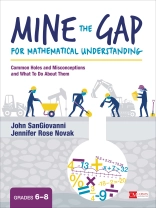Being an effective math educator is one part based on the quality of the tasks we give, one part how we diagnose what we see, and one part what we do with what we find. Yet with so many students and big concepts to cover, it can be hard to slow down enough to look for those moments when students’ responses tell us what we need to know about next best steps. In this remarkable book, John San Giovanni and Jennifer Rose Novak help us value our students’ misconceptions and incomplete understandings as much as their correct ones—because it’s the gap in their understanding today that holds the secrets to planning tomorrow’s best teaching.
The authors lay out 180 high-quality tasks aligned to the standards and big ideas of Grades 6–8 mathematics, including number systems, integers, ratio and proportion, equations and expressions, geometry, and statistics and probability. The tasks are all downloadable so you can use or modify them for instruction and assessment. Each big idea offers a starting task followed by:
- what makes it a high-quality task
- what you might anticipate before students work with the task
- four student examples of the completed task showcasing a distinct ‘gap’
- commentary on what precisely counts for mathematical understanding and the next instructional steps
- commentary on the misconception or incomplete understanding so you learn why the student veered off course
- three additional tasks aligned to the mathematics topic and ideas about what students might do with these additional tasks
It’s time to break our habit of rushing into re-teaching for correctness and instead get curious about the space between right and wrong answers. Mine the Gap for Mathematical Understanding is a book you will return to again and again to get better at selecting tasks that will uncover students’ reasoning, better at discerning the quality and clarity of students’ understanding, and better at planning teaching based on the gaps you see.
Tabella dei contenuti
Big Ideas and Tasks at a Glance
Acknowledgments
About the Authors
Introduction
Chapter 1. Rich Mathematics Tasks, Student Misconceptions, Using Tasks
Prompts With Purpose: Using High-Quality Tasks
Using Quality Tasks
Reflecting on Chapter 1
Chapter 2. Number Systems
Big Ideas
1. Addition and Subtraction of Fractions
2. Multiplication and Division of Fractions
3. Reasoning About Addition and Subtraction of Fractions
4. Reasoning About Multiplication and Division of Fractions
5. Problem Solving With Fractions
6. Decimals as Numbers
7. Addition and Subtraction With Decimals
8. Multiplication and Division With Decimals
Chapter 3. Integers
Big Ideas
9. Representing Integers
10. Representing Integers on Number Lines
11. More Representing Integers on Number Lines
12. Comparing Integers
13. Addition With Integers
14. Subtraction With Integers
15. Multiplication With Integers
16. Division With Integers
Chapter 4. Ratio, Proportion, and Percent
Big Ideas
17. Representing Ratios
18. Equivalent Ratios
19. Unit Rates
20. Using Ratios to Solve Problems
21. Reasoning With Percents
22. Unit Rate as Slope
Chapter 5. Expressions, Equations, and Functions
Big Ideas
23. Writing Expressions
24. Evaluating Expressions
25. Equivalent Expressions
26. Writing Equations
27. Solving Equations
28. Inequalities
29. Function Tables
30. Reasoning About Graphing
31. Comparing Functions
32. Systems of Equations
Chapter 6. Geometry
Big Ideas
33. Area of Composite Figures
34. Nets and Three-Dimensional Figures
35. Surface Area and Volume
36. Volume of Cylinders and Cones
37. Angle Relationships
38. Transformations, Similarity, and Congruence
39. Distance and Pythagorean Theorem
Chapter 7. Statistics
Big Ideas
40. Univariate Categorical Data
41. Univariate Quantitative Data
42. Displays of Univariate Quantitative Data
43. Deviations From the Mean
44. Bivariate Categorical Data
45. Bivariate Quantitative Data
Chapter 8. What Do We Do Next?
References and Additional Resources
Circa l’autore
John J. San Giovanni is a mathematics coordinator in Howard County, Maryland. There, he leads mathematics curriculum development, digital learning, assessment, and professional development. John is an adjunct professor and coordinator of the Elementary Mathematics Instructional Leadership graduate program at Mc Daniel College. In addition to this Figuring Out Fluency series, some of his many Corwin books include Daily Routines to Jump-Start Problem Solving, Grades K-8, Answers to Your Biggest Questions about Teaching Elementary Math, the Daily Routines to Jump-Start Math series, and Productive Math Struggle: A 6-Point Action Plan for Fostering Perseverance. John is a national mathematics curriculum and professional learning consultant who also speaks frequently at national conferences and institutes. He is active in state and national professional organizations, recently serving on the board of directors for the National Council of Teachers of Mathematics (NCTM) and currently on the board of directors for the National Council of Supervisors of Mathematics (NCSM).












